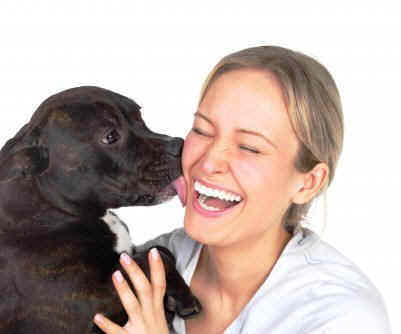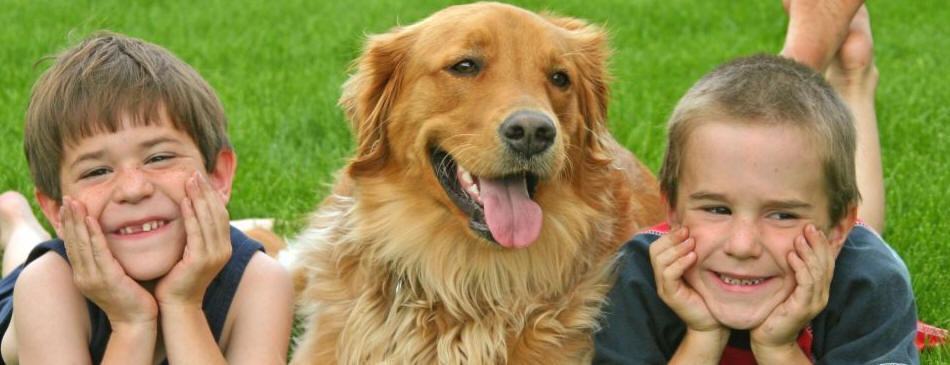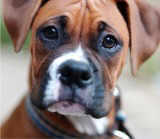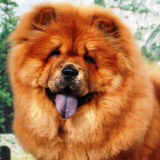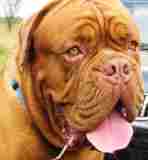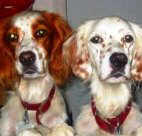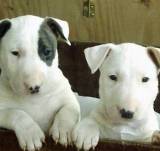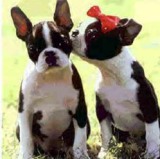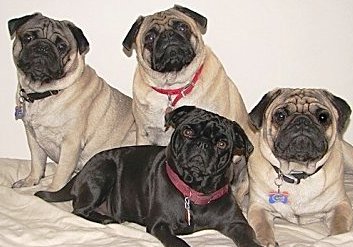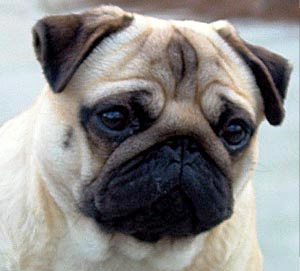|
The Pug is well described by the phrase "multum in parvo" which
means "a lot of dog in a small space." They are recognized for their
even-tempers, playful personalities, and their outgoing, loving
dispositions. This square and cobby breed comes in fawn, silver
fawn, apricot fawn or black, with a well-defined "mask" on his
muzzle. A popular companion dog, the pug also excels in the show
ring. The Pug is one of the oldest breeds of dogs and has flourished
since before 400 BC. Most researchers agree that the breed comes
from Asia, due to its similarities to the Pekingese. China is the
earliest known source for Pugs, where they were pets of the Buddhist
monasteries in Tibet. The breed next appeared in Japan and Europe,
becoming popular when Prince William II became the King of England.
He owned Pugs and they became the fashionable breed for generations.
General Appearance
The Pug has a square, thickset, stocky compact, body, with a sleek,
soft coat that comes in apricot, fawn, black and silver - all with a
short, flat, black muzzle and velvety ears. Rose shaped ears are
preferred. Moles on the cheeks are considered beauty spots. The eyes
are prominent, expressive, dark and lustrous. The teeth should meet
in a slightly undershot bite. The back is short, with a level
topline. Their tail lays in a tight curl, or in the best specimens,
a double curl on the back. Their limbs are straight and strong which
gives them a jaunty, rolling gait that is quite distinctive.
Temperament
The Pug is a good natured, sociable creature that likes to play and
have fun, but is not an overly active dog. These dogs are more
inclined to snuggle up and have a nap than to frolic around,
although some can be very entertaining to be around. A loving,
affectionate, yet not overly demanding dog, the Pug is well suited
to those with no experience of dog ownership as well as the more
experienced. The Pug is not the ideal choice for a guard dog or
watchdog, as he is small, a little too sociable to be daunting, and
prefers to communicate through grunting rather than barking. His
table temperament and friendly nature makes the Pug a good family
pet, and he is also ideal as a companion dog for the elderly or
anyone that just wants a peaceful friend. These dogs get along well
with children and other animals, although jealousy can strike if
another pet gets more attention than them. They will also get along
well with strangers. They are intelligent, and training should not
prove too challenging, but housebreaking can be another matter. Some
can be quite stubborn and strong minded, but most are sweet and
sensitive. They love their creature comforts, and enjoy the
affection and attention of their owners. These charming dogs do have
a tendency to look grouchy because of their wrinkly faces and short
snouts, but most are anything but.
Grooming
Grooming wise, the Pug does not require much maintenance. The muzzle
area should be cleaned as this breed has the tendency to drool.
Under the folds of skin should also be cleaned to avoid any dry or
itchy skin. Bathing should only be performed when necessary, as it
will remove the natural oils from the skin and coat.
Health Problems and Life Expectancy
Pugs are usually healthy and hearty dogs. The most common problem is
that the pugs suffer from obesity because they seem to love to
overeat Pugs, because of their short noses, are also prone to
breathing, respiratory, and snoring issues. Be particularly vigilant
and cognizant when the weather or temperature is hot, humid, and
cold. Most of the respiratory issues revolve around elongated soft
palates and pinched nostrils. Pug dog encephalitis is a condition
that is being researched because it seems to be related to genetics.
Its symptoms are seizures, circling, blindness, coma and death. It
is a rapid degenerative disease that can be fatal in a matter of
weeks. However, pugs can suffer from Epilepsy and these seizures can
be totally unrelated to encephalitis. The life expectancy of the Pug
is around 12-13 years.
Activity Level
Pugs are lively little dogs, however they are relatively active
indoors and do well without a yard. This breed does love long walks,
but proper water should always be provided as this breed is prone to
breathing problems and tires quickly. This breed is excellent for an
apartment environment. The Pug adapts well to many different
environments, and will take as much exercise as provided.
|
